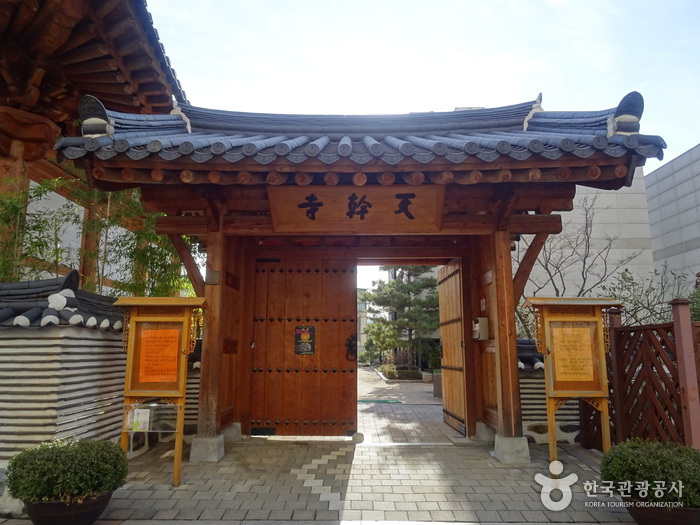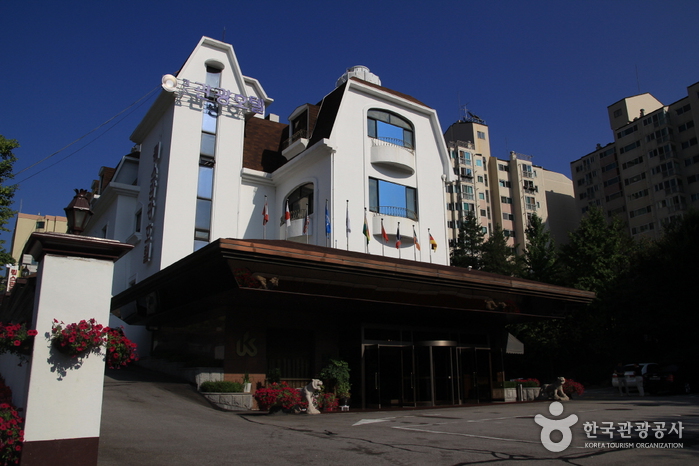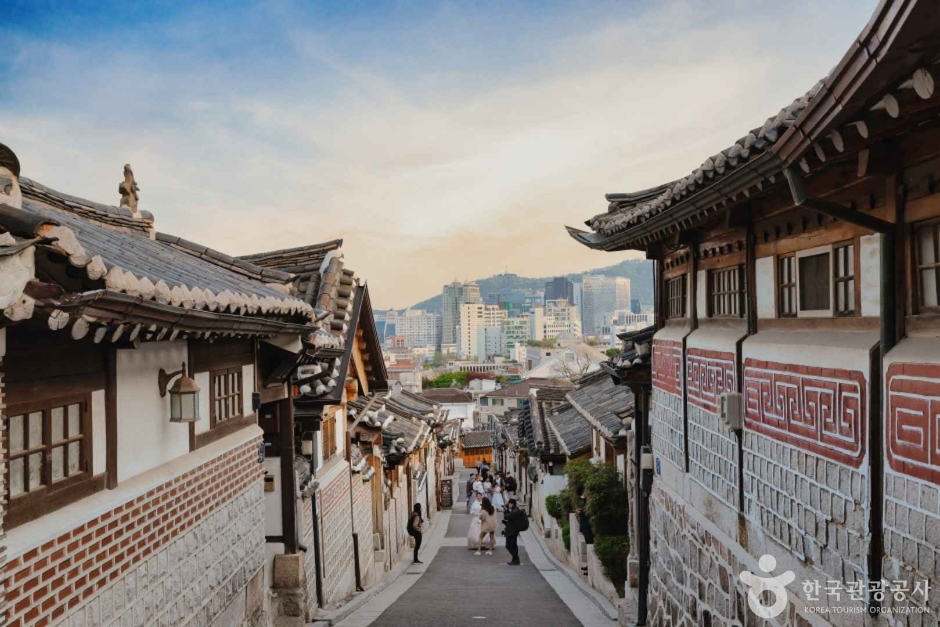Inwoohouse [Korea Quality] / 인우하우스 [한국관광 품질인증]
3.6Km 2023-09-12
1-9 , Gyedong 6-gil, Jongno-gu, Seoul
+82-2-742-1115
Inwoo House is a traditional hanok down an alley in Gye-dong, Jongno, Seoul. There is a swallow's nest under the eaves, and the pride of this house is that the swallow family returns every spring. Each room in the house has a private bathroom. Residents can sample Korean culture by taking part in traditional paper crafts, knot bracelet making, and fan decorating. The location is convenient for restaurants, cafes, and convenience stores, and Gyeongbokgung Palace, Changdeokgung Palace, Insadong, and Samcheong-dong are all within walking distance.
Eight Scenic Views of Bukchon (북촌 8경)
3.6Km 2024-03-18
37, Gyedong-gil, Jongno-gu, Seoul
+82-2-2148-4161
The Eight Scenic Views of Bukchon can be found at the Bukchon Hanok Village between Gyeongbokgung Palace and Changdeokgung Palace. Bukchon was historically a district where the aristocracy of Joseon had resided in, so it is still home to a large number of traditional dwellings, called hanok in Korean. The eight views are as follows: No. 1, view of Chengdeokgung Palace; No. 2, view of Wonseo-dong Handicraft Road; No. 3, view of the Gahoe-dong area; No. 4, view from the hill at Gahoe-dong (Bukchon Observatory); No. 5, the view of the road uphill at Gahoe-dong; No. 6, the view of the road downhill at Gahoe-dong; No. 7, the view at house number (beonji) 31, Gahoe-dong; No. 8, the view of the stone stairway at Samcheong-dong.
Cheongansa Temple (천간사)
3.6Km 2021-10-12
20-8, Bulgwang-ro 10-gil, Eunpyeong-gu, Seoul
+82-2-355-7430
Cheongansa Temple was first built in 1960, and was re-built in 2009. It has many pagodas and monuments: a pagoda filled with sari relics of Buddha; Budotap Pagoda, which is a shrine to the monk who found the temple and his sacred relics; and a monument honoring the late first lady Yuk yeong-su. The re-built temple was awarded the Hanok Prize in the Hanok Competition 2011. Located along the Bukhansan Mt. Dulaegil Trail, the temple provide visitors with the chance to enjoy fresh air and a rest from hiking along the trail.
EW Spao - AK & Hongdae Branch [Tax Refund Shop] (EW 스파오 AK&홍대)
3.6Km 2024-04-18
4F, B188 Yanghwa-ro, Mapo-gu, Seoul
-
Donghwa Kim's Hotel (동화킴스관광호텔)
3.6Km 2021-01-19
136, Pyeongchangmunhwa-ro, Jongno-gu, Seoul
+82-2-379-0520
Donghwa Kim's Hotel, located in Jongno-gu, Pyeongchang-dong, was designed to give the impression of a mountain cabin while combining Korean and modern architectural elements, resulting in a structure of notable artistic taste. The four-story hotel has 51 comfortable guestrooms, a banquet hall, a coffee shop, a Western restaurant, and a Korean restaurant. The hotel offers a wide-open view of the neighboring Bugaksan Mountain.
The Hanok (더 한옥)
3.6Km 2021-03-24
75, Gyedong-gil, Jongno-gu, Seoul
+82-2-743-7470
You can enjoy coffee in a hanok (Korean house). This restaurant's signature menu is coffee. This cafe is located in Jongno-gu, Seoul.
Gangseo Myeonok (강서면옥)
3.6Km 2020-04-17
35, Sejong-daero 11-gil, Jung-gu, Seoul
+82-2-752-1945
Gangseo Myeonok has been famous for over fifty years, having been the food of choice served to visiting dignitaries from North Korea at the time of the South-North Red Cross Conference. The restaurant has succeeded in carrying on the tradition of Pyeongyang-style naengmyeon. The native buckwheat from Gangwon-do mixed with starch makes for fine noodles, and the wonderful broth is made from beef brisket with white radish kimchi.
Bukchon Hanok Center for History (북촌한옥역사관)
3.6Km 2024-11-05
3 Gyedong 4-gil, Jongno-gu, Seoul
Insa-dong Geujip (인사동그집)
3.6Km 2024-03-18
3 Insadong 12-gil, Jongno-gu, Seoul
+82-2-737-0575
Insa-dong Geujip is a hanok-style Korean restaurant located in a narrow alley in Insa-dong. Their signature dish, bulgogi yachaemari (bulgogi and vegetable roll), allows you to choose between stir-fried pork bulgogi, beef bulgogi, or chicken bulgogi. Visitors can enjoy the tangy and sweet flavor of the radish wrap filled with bulgogi and julienned vegetables, accompanied by side dishes and soybean paste stew. They also offer bulgogi nakji jeongol (bulgogi and octopus hot pot), cheolpan sogalbijjim (stir-fried marinated galbi on hot iron plate), and dolsot bibimbap (hot stone pot bibimbap) along with hahu yukhoe bibimbap (Korean beef tartare bibimbap).
Bukchon Hanok Village (북촌한옥마을)
3.6Km 2025-06-19
37 Gyedong-gil, Jongno-gu, Seoul
Surrounded by Gyeongbokgung Palace, Changdeokgung Palace and Jongmyo Shrine, Bukchon Hanok Village is home to hundreds of traditional houses, called hanok, that date back to the Joseon dynasty. The name Bukchon, which literally translates to "northern village," came about as the neighborhood lies north of two significant Seoul landmarks, Cheonggyecheon Stream and Jongno. Today, many of these hanoks operate as cultural centers, guesthouses, restaurants and tea houses, providing visitors with an opportunity to experience, learn and immerse themselves in traditional Korean culture. As Bukchon Hanok Village is an actual neighborhood with people's homes, visitors are advised to be respectful at all times while looking around.
![Inwoohouse [Korea Quality] / 인우하우스 [한국관광 품질인증]](http://tong.visitkorea.or.kr/cms/resource/56/3009456_image2_1.jpg)


![EW Spao - AK & Hongdae Branch [Tax Refund Shop] (EW 스파오 AK&홍대)](http://tong.visitkorea.or.kr/cms/resource/64/2888864_image2_1.jpg)




 English
English
 한국어
한국어 日本語
日本語 中文(简体)
中文(简体) Deutsch
Deutsch Français
Français Español
Español Русский
Русский